В.Кондратьев Самолеты первой мировой войны
КАПРОНИ Ca.4 / CAPRONI Ca.4
В конце 1916-го Капрони создал, пожалуй, наиболее экстравагантный аэроплан 1-й Мировой войны. Задавшись целью резко увеличить бомбовую нагрузку машины, он установил на очередную модификацию своего бомбардировщика более мощные, 200-сильные, моторы "Фиат". А чтобы компенсировать возросший взлетный вес, добавил третье крыло.
Напомним, то был период всеобщего увлечения трипланами, но Капрони - единственный, кто сумел разработать и, главное, "довести до ума" тяжелый многомоторный самолет подобной схемы. Все остальные проекты так и не вышли за стадию прототипов, а гигантский триплан Ca.40 выпускался серийно и участвовал в боевых вылетах.
Конструкция Ca.40 в целом была та же, что и у предыдущих машин Капрони: деревянный каркас с полотняной обшивкой. Новинкой стали восьми колесные тележки шасси и крупногабаритный бомбовый контейнер, размещенный в центре нижнего крыла подфюзеляжной гондолой. Бомбы в нем подвешивались вертикально. Экипаж - 5 человек: 2 пилота и 3 стрелка.
В начале 1917-го появился слегка улучшенный образец Ca.41 с более узкой, обтекаемой гондолой и тандемным расположением пилотов. Вершиной развития типа стал Ca.42, на который Капрони установил самые мощные на тот момент 400-сильные американские двигатели. "Либерти", По величине бомбовой нагрузки этот самолет не имел себе равных в авиации союзников. В 1917-м построили лишь 3 серийных бомбардировщика-триплана и еще 20 - в следующем году.
Высокая грузоподъемность Ca.42 (военное обозначение - Ca.4) привлекла внимание английского морского командования. Для авиации ВМФ Великобритании было закуплено 6 машин, которые состояли на вооружении до конца 1918-го. Остальные применялись двумя итальянскими бомбардировочными эскадрильями. Поскольку огромный тихоходный самолет представлял отличную мишень для вражеских зениток, Ca.4 почти всегда летали на задания ночью.
Кроме уже упомянутых, выпускалось и еще несколько модификаций двухбалочных трипланов Капрони: торпедоносец Са:43, Ca.51 с бипланным оперением, а также Ca.48, Ca.52, Ca.58 и Ca.59 - транспортные самолеты без вооружения. Всего было построено свыше 40 аэропланов семейства Ca.4.
ДВИГАТЕЛИ
3 "Фиата" по 200 л.с. или 3 "Либерти" по 400 л.с.
ВООРУЖЕНИЕ
Носовая двухпулеметная турель в гондоле и еще две - в хвостовых балках за крыльями.
Ca.4 с двигателями "Фиат" поднимал 1200 кг бомб, с двигателями "Либерти" - 1950 кг.
ЛЕТНО-ТЕХНИЧЕСКИЕ ХАРАКТЕРИСТИКИ
Ca-42, 1916г.
Размах, м 29,90
Длина, м 15,10
Высота, м 6,30
Площадь крыла, кв.м 200,0
Сухой вес, кг 4000
Взлетный вес, кг 7500
Двигатель: "Либерти"
число х мощность, л. с. 3x400
Скорость максимальная, км/ч 140
Дальность полета, км 600
Продолжительность полета, час, мин 5,0
Время набора высоты, мин/м 26/3000
Потолок, м 4900
Экипаж, чел. 5
Вооружение 3-6 пулеметов
1950 кг бомб
А.Шепс Самолеты Первой мировой войны. Страны Антанты
Ca-4 1916 г.
Эта машина создавалась с целью повышения бомбовой нагрузки и усиления защиты от атак истребителей противника. Для этого инженеры фирмы "Капрони" почти в два раза увеличили размах крыльев новой машины по сравнению с Ca-33. Самолет стал четырехстоечным трипланом. На нижнем крыле по продольной оси самолета устанавливался ящик для бомб, в котором размещалось около 2000 кг бомб в вертикальном положении. Гондола экипажа и несущие балки фюзеляжа с мотогондолами устанавливались под средним крылом.
Двигатели 12-цилиндровые, жидкостного охлаждения, рядные, от 300 до 400 л. с. фирмы "Фиат" или американские "Либерти". В балках за задней кромкой крыла монтировались турельные установки со спарками пулеметов "Ревелли".
Гондола экипажа приобрела овальную, обтекаемую форму. Оперение большего размаха, конструктивно повторяло оперение самолета Ca-33. Шасси на трубчатых М-образных стойках имело по две короткие оси на каждой стойке. На каждой оси устанавливали по две спарки колес. Костыли имели большую длину и во избежание поломки крепились сложной системой раскосов и растяжек. Самолет нес 4-6 пулеметов и до 1950 кг бомб. Кроме итальянских эскадрилий несколько машин было передано британским ВВС и американскому экспедиционному корпусу. Но из-за довольно сложной и непрочной конструкции самолет распространения не получил.
Модификации
Ca-41 - серийный самолет с тремя двигателями "Фиат" (300 л. с.).
Ca-42 - развитие предыдущего с более мощными двигателями "Либерти" по 400 л. с.
R.Abate,G.Alegi,G.Apostolo Aeroplani Caproni: Gianni Caproni and His Aircraft, 1910-1983
April 1916 had seen the static testing of the Ca.4, a trimotor triplane which earned the Caproni formula to its extremes. Based on the biplanes’ concept and structure, the Ca.4 stood out because of its much greater size and power. Although it could carry over a ton of bombs, the Ca.4 was penalised by excessive structural complexity and less than fifty were completed in a surprisingly large number of variants.
O.Thetford British Naval Aircraft since 1912 (Putnam)
CAPRONI CA.42 TRIPLANE
Six examples of this three-engined triplane bomber were purchased from Italy for the RNAS, but were not, so far as is known, used operationally although originally intended for NO.227 Squadron at Pizzone, in April 1918. They had the serial numbers N526 to 531 inclusive: N527 is illustrated.
J.Davilla Italian Aviation in the First World War. Vol.2: Aircraft A-H (A Centennial Perspective on Great War Airplanes 74)
Caproni Ca. 4
The Caproni Squadriglias used the excellent Caproni 2 and 3 series aircraft throughout 1915, 1916, and 1917. The aircraft enabled the Italians to establish an effective long range strike force, but the airframes suffered from unreliable engines. By the end of 1916 it as clear that a new design with engines that were both more reliable and could deliver more power were needed.
Caproni decided to produce an entirely new replacement, a huge triplane with Isotta Fraschini V5 engines. The problem was that Caproni was not only stretching the boundaries of 1915 aircraft technology, but also the very limited capabilities of the Italian aircraft industry. Caproni, like Douhet, was a believer in the tenet that masses of bomber aircraft could bring about a decisive victory, even without the contribution of armed troops or navies. His decision to make the new bomber a massive flying juggernaut doomed the project.
The deficiencies of the Caproni 2 and 3 were readily understood by the Aviazione Militaire. It had been planned to replace them with the new S.I.A. 14b triplane bombers. However, developmental problems (whether with the airframe or the 700-hp Fiat A.14 engines) resulted in the military losing interest in the project.
Caproni was now the only option, and his new bomber would have to be powerful enough to climb over the mountains fining the Italian front, have superior range, be free of any major structural defects, and have reliable engines. The Ca.4 would be unable to meet almost every one of these requirements.
The triplane layout could help make the new design’s ceiling superior to the marginal ceiling of the Ca.3s.
However the Ca.3s Achilles’ heel were its 100-hp Fiat A.10s which were not powerful enough and were unreliable. The Ca.4 would use the 200-hp Isotta Fraschini V5 eight-cylinder inline engines, twice as powerful as the A.10s.
To ensure that he Ca.4 would be a truly strategic bomber, the full capacity would be 1,118 kg of fuel, enough for its crews to fly seven hour missions.
Testing
The Ca.4s first flight came on 6 July 1916. By all accounts, including Caproni’s own diary, both the aircraft and engines worked properly. The chief test pilot, Pensuti, described it as being maneuverable and easy to land. Aside from some minor alterations to the propellers and tailplane, the aircraft appeared to be poised for success. Not so, however, the Isotta Fraschini motors which even at this early stage were beginning to cause problems.
Tests continues with the Ca.4 being flown at higher altitudes for longer periods of time. Alegi notes that by the end of 1916 it had completed 40 test flights. Trials with various modifications to the prototype airframe were tested including the crew layout, cockpit configuration, radiators and propellers.
They Italian aviation industry was plagued by its inability to produce reliable, powerful, and easy-to-manufacture engines. This failure would hamstring Italian designs not only in the First World War, but also the Second where most medium bombers would need to have three engines and where its best fighters were those fitted with German DB 605 motors.
Sadly, the Ca.4’s Isotta Fraschinis would follow this pattern. Testing revealed a higher than expected fuel consumption (reducing range), slower climb rate (limiting usefulness over the Alpine mountains), and a production rate which was merely 25% of the planned yearly output of 400 motors.
Alternative power plants also had their own unique problems. The Fiat A.14 planned for the Ca.3s replacement (the S.I.A. 14b) had a maximum endurance without breakdowns of between 5 and 6 hours. In desperation the 400-hp Tossi engine was test fitted to two V5 prototypes without success. Caproni had no choice but to return to the trimotor configuration that would be the Italian industry’s fallback position for the next 30 years. The somewhat more reliable Fiat A.12 variants were tested on the Ca.5.
The Direzione Generale di Aeronautica (Directorate General of Aeronautics, DGA) had planned to order 100 S.I.A. 14bs with the 700-hp Fiat A.14s; they were only interested in continuing to produce Ca.3s until the new bomber became available. Caproni’s response was to start a campaign to push for his new bomber in political and media circles. The problems with the new S.I.A. 14b won the day for Caproni; in late January 1917 DTAM requested a first batch of 36 Ca.4s. On April 30,1917 military tests began at Vizzola Ticino. These tests resulted in a small victory for Caproni - the DTAM agreed to purchase the prototype.
Variants
Ca. 41 - This designation was applied to the prototype and the first three production examples. Caproni re-designated them as Ca.40s after the war.
In order to improve the aircraft’s aerodynamics, the angular nacelle was replaced with a more streamlined shape in which the crew were now seated in tandem. A dozen examples of this improved variant (later re-designated Ca.41) were built.
Ca.42 - The Ca.41 was fitted with three American-manufactured 350-400-hp Liberty engines and a bomb rack under the lower wing (post-war designation Ca.42). The crew was two pilots, a gunner in each wing, and and a nose gunner in the central nacelle.
The payload was improved by 500 kg to 3,500 kg, the speed increased by 15 km/h to 140 km/h, and a faster climb to 3,000 metres in only 1 hour 24 minutes.
Armament was a 1,000 kg bomb load and three machine gun mounts for single or paired weapons.
Ca.43 - One Ca.41 (Ca.5353) was equipped with two floats for potential use as a torpedo aircraft. The torpedo was carried under the central section of the wing. This conversion was produced in 1920, and retroactively designated the Ca.43.
Ca.48 - In 1918 a Ca.4 was adapted to carry passengers by the addition of a large cabin for 17 passengers under the central nacelle. Another six could be seated, in presumably considerably less comfort, between the pilot and the rear central engine. This aircraft was later re-designated Ca.48.
Ca.49 - An unbuilt project project for a four-engine seaplane.
Ca.51 - Variant with a biplane horizontal tail with, in the centre, a cockpit housing a gunner in a tail defense position.
Ca.52 - Version of the Ca.42 built for the Royal Naval Air Service for use on the Italian front. Caproni’s book reports that these aircraft had varying types of engines, armament, internal details, etc. Most sources list the RNAS triplanes as Ca.42s, however.
Ca.58 - A proposed thirty passenger transport version with three 700-hp engines (Fiat A.14?). Unlike the Ca.48, the cabin of this aircraft featured luxurious accommodations on two floors connected by an internal stairway. There was a bar, toilet and baggage storage.
Ca.59 - Ca. 58 powered by five Isotta Fraschini V.7 400-hp engines (two were carried in gondolas outside the two booms).
Alegi mentions several undesignated bomber variants with 500-hp Bugatti water cooled engines or Fiat A.14s. The day bomber carried a crew of three, four defensive machine guns, and a 1,100 kg bomb load. Another version had a crew of seven between 12 and 15 defensive machine guns plus a 37 mm cannon. As a result of all these additions, the bomb load fell by over half to 500 kg.
Production
Ca.4 (1916 -1919 are all Ca.33s)
1916 - 1
1917 - 250 with serial batches Ca.2309-2408; Ca.4037-4086, Ca.4137-4236
1918 - 40; Ca.11488-11507
1919 - 8
1923 - 23 (Ca.36)
1924 - 80 (Ca.36)
1925 - 40 (Ca,36)
1926 - 10 (Ca.36)
From Alegi Caproni Ca.4
Operational Service
A total of 250 aircraft had been ordered in 1917, by January 1918 12 had been completed. In an attempt to streamline production, Douhet decided to limit the bomb-bay gondolas to 162-mm and 260-mm weapons.
In late May the Comando supremo declared the aircraft unsuitable for use over land and released them to the Regia Marina, who subsequently released them the Aviazione who used them over land!
Alegi cites a document that sheds light on the feelings among the aircrews flying the aircraft: ...The aircraft climbs slowly and in daylight can be an easy prey for both antiaircraft artillery and fighters. Its size makes it an easy target for the former and the latter.
The ground crews were kept busy installing new cockpit bulkheads, windscreens, and changing the propeller (a frequent problem with Caproni’s aircraft, see section on Ca.1, 2, and 3).
XXII Gruppo, now fully equipped with Ca.4 triplanes, was assigned the task of attacking the railway plants and the military installations of Bolzano and Bressanone. Its two squadriglias had spent the first half of the month on test flights and on 18 July four 181a aircraft were prepared for an attack on the station and depots of Calliano, on a what would be essentially a practice mission. There was some trepidation on the part of the crews aa a shorty before this mission, a Ca.4 of 182a Squadriglia had crashed killing its four airmen. However, only the first triplane hit the target as the second crashed on takeoff, also in this case due to the failure of an engine. The mission was cancelled for the remaining two aircraft. The following night an attempt was made to bomb Bolzano with four Ca.4s but engine problems forced them to disperse their load of bombs and printed matter between Dro, Lavis and Mattarello, and then returned to Ghedi.
The investigation by the Direzione tecnica dell’aviazione militate (Technical Directorate of Military Aviation) established that the Ca.4s fuel system had to be replaced and the use of the Ca.4 was suspended. Flight activity resumed with great caution in the second half of August, but in the afternoon of the 29th the Ghedi field was devastated by a storm of wind and rain which damaged the aircraft based there. On 14 September the Comando superiore di aeronautica (Air Force Superior Command) ordered that the two squadriglias move to Poggio Renatico, in order to provide support to the Regia Marina, and on 20 September XXII Gruppo was disbanded.
It is perhaps fortunate that the Ca.4s went into action when the Austro-Hungarian air force was all but destroyed; there does not appear to be any recorded instances of the triplanes actually coming under attack on bombing missions. The fact that many sorties were flown in broad daylight attests to the parlous state of the KuK.
On 20 December N528 moved to Rome, where it was incorporated in the new Gruppo Sperimentale Comunicazioni Aeree (Experimental Air Communications Group, GSCA) and made propaganda flights, including an aerial escort during the visit of US president Woodrow Wilson.
N529 flew from Rome to Constantinople. Flown by Tenente Simonelli and Sergente Pesce, it left Rome on 9 June and reached Constantinople a week later, after several stop-overs and sundry minor problems. On the 20th N529 participated in a mass flight over Hagia Sophia, but it is unclear whether or not it returned to Italy; it was the Ca.4s last taste of glory, as a flight to Tokyo failed.
Foreign Service
United Kingdom
Ray Sturtevant reports that five Ca.4s were accepted “on loan” from Italian Government under Cont No A.S.13174 (BR.62), This RNAS variant was retrospectively redesignated Ca 42 by Caproni.
After testing began in March 1917 (with Pensuti, himself, making the first test flight) they were formally accepted in November of that year.
They were considered for use for anti-submarine patrols in Southern Italy.
All had Fiat engines, except for N527 which used V.5s.
All five went to Northern Squadron 6 at Otranto in January 1918. All were listed as being returned to the Italian government in March 1918. No. 6 Wing at Malpensa had N526 in November 1918 while N527 was serving with No. 6 Wing in Vizzola in November 1918.
United States
The United States Air Service considered producing the Ca.4 under license for use as a strategic bomber. When it was learned that the Italians were abandoning the Ca.4 for the Ca.5, they decided not to pursue the matter.
Among the Italian aircraft sent to America was 5349 as part of the Italian aviation mission , which left Genova aboard the steamer Verona on 16 August and was assembled at Langley Field.
The process was only completed in November. In the afternoon of 1 December 1917 the bomber crashed on take-off following an engine failure. Pilot Tenente Antonio Resnati and his three crew members were unhurt, but the planned American tour was over.
Caproni 4 (Ca.40) bomber with three 200-hp FIAT A.12 engines
Wingspan 29.90 m; length 13.10 m; height 6.30 m; wing area 200 sq m
Empty weight 3,500 kg; loaded weight 6,500 kg
Maximum speed 125 km/h; climb to 3,000 m in 60 minutes
Caproni 4 (Ca.41) bomber with three 200-hp FIAT A.12 engines
Wingspan 29.90 m; length 13.10 m; height 6.30 m; wing area 200 sq m
Empty weight 3,500 kg; loaded weight 6,500 kg
Maximum speed 135 km/h; ceiling 4,000 m
Caproni 4 bomber with three 400-hp Liberty A.12 engines
Wingspan 29.90 m; length 13.10 m; height 6.30 m; wing area 200 sq m
Empty weight 4,000 kg; loaded weight 7,500 kg
Maximum speed 140 km/h; climb to 1,000 m in 6 minutes; climb to 3,000 m in 24 minutes; ceiling 5,000 m
Журнал Flight
Flight, June 19, 1919.
THE, CAPRONI BOMBING TRIPLANE CA-4-1915
THE Caproni triplane represents a type designed and built by the famous Italian constructor since 1915. This machine was created at that time for the night bombing of important military and naval bases, railway stations and war plants. As in the preceding types of machines by the same constructor, the type CA-4 triplane has for its distinctive characteristic the number and arrangement of the motors, originated by the famous Italian constructor. There are three motors, one driving a pusher screw mounted in a central nacelle, the other two are each mounted in the nose of a fuselage and drive a tractor screw. These two fuselages and the central nacelle are attached to the spars of the middle wing, whilst the centre section of the lower plane carries the bomb rack, also designed by Engineer Caproni.
Normally the crew of the machine consists of two pilots, seated side by side, and a gunner - who operates a 1 1/2 in. gun and two Fiat machine guns - located in the central nacelle, and a gunner or observer in each of the fuselages, which are also fitted with Fiat machine guns. Each of the crew can pass from one cockpit to another, a foot walk covered with veneer wood being provided on the middle plane between the central nacelle and the fuselages for this purpose.
The CA-4 triplane has been successively equipped with three different types of motors. At first, three Isotta Fraschini 8-cylinder vertical 240-250 h.p. engines were used; later three Fiat A/12-bis 6-cylinder vertical engines were fitted, and finally three Liberty 12 Navy type (low compression) engines were adopted. With an aggregated useful military load of 6,600 lbs. the performance of this triplane, equipped with Liberty engines, has been considerably better than those obtained with the other types of motors, especially in climbing. In the official tests, at full load and fully armed, a speed of 98 m.p.h. at 6,560 ft. was reached. The average rates of climb attained (with Liberty motors) at full military loads were: 3,280 ft. in 6 mins., 6,560 ft. in 14 mins., and 10,000 ft. in 25 mins. The ceiling is at about 16,000 ft. The total weight of the machine, empty, is 11,100 lbs., and with full military load, 17,700 lbs. With a complete fuel load of 550 gals, the bomb rack is supposed to be loaded with 2,500 lbs. of bombs, but practically in almost all bombing raids the load of bombs exceeded 3,000 lbs.
Each of the three planes is built up in seven sections, the corresponding sections in upper, middle and lower planes being of equal span, as follows. Centre sections, 5 ft. 6 ins.; intermediate sections (two), 13 ft. 1 in. each, and outer sections 18 ft. 3 ins. The wing spars are of box spar section, and the ribs, double ribs and box ribs are of white wood and ash. Between ribs the spars are wrapped with strong linen. The connection between the two subsequent sections is obtained with the male and female box fitting system. The covering is linen, nailed on the rib flanges and on the leading and trailing edges. On the linen, above and below the wing, maple batten strips are screwed in correspondence to the ribs.
For the interplane struts, ash, spruce and seamless steel tubes are employed, and some of the struts have adjustable ends. The bracing is, as usual, with steel cables and wires.
As on all Caproni bombing machines, the stabiliser, elevator, rudders and ailerons are constructed of steel tubing. The stabiliser is solidly braced to the fuselage by means of cables and steel tube struts. There are three balanced rudders and a one-piece elevator. Ailerons are fitted to all three planes. Dual control is fitted, so that the machine can be controlled by either pilot at will. The control system for the ailerons and elevator is a combination of the wheel and stick type, and the rudders are operated by a foot bar of the usual pattern.
The petrol is fed from three tanks, one each on the fuselages and one in the central nacelle. Three wind-driven centrifugal pumps deliver the petrol from the tanks to a central distributor, and thence to the carburettors of the engines. Both pilots have close a t hand the necessary devices for controlling the petrol supply. For testing the motors on the ground two small gravity tanks are provided, but these are excluded from the main system when the machine is in flight. In cases of emergency the pilot on the left can operate a hand-pump, which is capable of feeding the three engines from the central tank. Each engine has its own oil tank and a radiator for cooling the oil. The engine radiators are mounted either in the nose of the respective fuselage or nacelle, or else above in each engine, as shown in the photographs. All the radiators are of the honeycomb type, and are fitted with shutters.
The central nacelle is perfectly streamlined. Two main longerons with steel tube compression struts between them, wire braced, form the frame on which a set of ribs are fastened, giving the shape of the nacelle. Birch veneer and walnut are employed in the construction of these ribs - a similar form of construction to that employed for flying boat hulls. The front upper part of the nacelle is formed by a cowling made of plywood with interposed layers of fabric. The two pilots are seated behind the front gunner, and behind them again is the petrol tank. At the rear of the latter, which is of the same circular section as that of the nacelle, is a short foot-way allowing free access to the engine at the rear. The engine is enclosed by cowling.
The two fuselages are flat-sided and of the usual girder construction - four ash longerons, compression struts, and wire bracing. All the fittings to which the diagonals are fastened are manufactured from the same set of dies, and are extremely simple, light and free from welding. Their application is such that the longerons are not pierced by bolts or screws. The engine housing is cowled with sheet aluminium. The petrol and oil tanks are situated just behind the engine. and the gunner's cockpit is located a short distance at the rear of the trailing edge of the middle plane. A tail skid is mounted on the end of each fuselage. The landing gear is of special Caproni design, and is very strong. It consists of two sets of M struts, each carrying a short skid on which are sprung two pairs of twin wheels mounted one in front of the other. Each set of wheels is located under the fuselages. The M struts are of laminated ash and spruce, wrapped with strong canvas fabric. The axles are attached to the skids by means of shock-absorbing rubber cord, and steel rods anchored in universal joints which absorb lateral oscillation. The chassis is braced in the usual manner with double steel cables.
The following are the principal characteristics of the Caproni CA-4 triplane :-
Overall span 96 ft. 6 ins.
Overall length 42 ft. 11 ins
Overall height 20 ft. 8 ins.
Chord 7 ft. 0 ins.
Gap 8 ft. 0 ins.
Area of main planes (total,
including ailerons) 2,223 sq. ft
Area of ailerons (six) 227 sq. ft.
Area of rudders (three) 81 sq. ft.
Area of tail plane 109.75 sq. ft.
Area of elevator 81.6 sq.ft.
Overall span of ailerons 19 ft. 4 ins.
Overall span of tail plane 34 ft. 1 in.
Overall span of elevator 36 ft. 3 ins.
Angle of incidence
(main planes) 3° 50'.
Angle of incidence
(tail plane) 3° 8'.
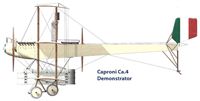 |
J.Davilla - Italian Aviation in the First World War. Vol.2: Aircraft A-H /Centennial Perspective/ (74)
|
| Caproni Ca.4, Demonstrator
|
 |
J.Davilla - Italian Aviation in the First World War. Vol.2: Aircraft A-H /Centennial Perspective/ (74)
|
| Caproni Ca.4 '16'
|
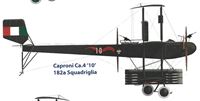 |
J.Davilla - Italian Aviation in the First World War. Vol.2: Aircraft A-H /Centennial Perspective/ (74)
|
| Caproni Ca.4 '10', 182a Squadriglia
|
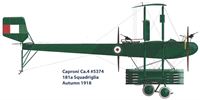 |
J.Davilla - Italian Aviation in the First World War. Vol.1: Operations /Centennial Perspective/ (73)
|
| Caproni Ca.4 #5374, 181a Squadriglia, Autumn 1918
|
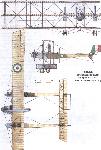 |
А.Шепс - Самолеты Первой мировой войны. Страны Антанты
|
| Тяжелый бомбардировщик Капрони Ca-42 ВВС Италии (1917г.)
|
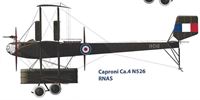 |
J.Davilla - Italian Aviation in the First World War. Vol.2: Aircraft A-H /Centennial Perspective/ (74)
|
| Caproni Ca.4 N526, RNAS
|
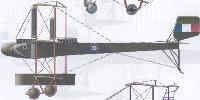 |
В.Кондратьев - Самолеты первой мировой войны
|
| Caproni Ca-4, 6 крыло Королевской Военно-морской Авиации Великобритании, 1918г.
|
 |
А.Шепс - Самолеты Первой мировой войны. Страны Антанты
|
| Капрони Ca-41 RFC (1917г.)
|
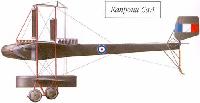 |
В.Обухович, А.Никифоров - Самолеты Первой Мировой войны
|
| Капрони Ca.4
|
 |
R.Abate, G.Alegi, G.Apostolo - Aeroplani Caproni: Gianni Caproni and His Aircraft, 1910-1983
|
| Further developing the multiengine multiplane theme, in 1916 Caproni conceived the Ca.4. This enormous triplane, powered by tre Fiat A.12bis engines, sacrificed everything to its load carrying possibilities. Tested in July 1916, it was ordered in production the following January.
|
 |
R.Abate, G.Alegi, G.Apostolo - Aeroplani Caproni: Gianni Caproni and His Aircraft, 1910-1983
|
| This visual comparison between the Ca.4 (redesignated Ca.40 after the war) and the 1914 Ca.20 illustrates the rapid strides in aviation technology brought about by the war. While the structural parts of the both aircraft were quite similar, before the war a project of the Ca.4's size would have been inconceivable.
|
 |
Jane's All The World Aircraft 1919 /Jane's/
|
| A 1,000 h.p. Caproni Triplane, of 1917, nose to nose with a 100 h.p. Caproni Monoplane of 1915 type.
|
 |
R.Abate, G.Alegi, G.Apostolo - Aeroplani Caproni: Gianni Caproni and His Aircraft, 1910-1983
|
| This photo, taken at Vizzola Ticino in late 1916 or early 1917, summarizes wartime Caproni production. Left to right: the Ca.4 prototype, the unique Ca.37 and Ca.20, and Ca.300 serial 1173.
|
 |
R.Abate, G.Alegi, G.Apostolo - Aeroplani Caproni: Gianni Caproni and His Aircraft, 1910-1983
|
| The preseries batch, later called Ca.40, had the prototype’s angular fuselage with a clear frontal section added for the observer.
|
 |
J.Davilla - Italian Aviation in the First World War. Vol.2: Aircraft A-H /Centennial Perspective/ (74)
|
THE 600 H.P. ITALIAN CAPRONI TRIPLANE. - This huge machine, the size of which may be judged by the man standing just in front, is equipped with three 200 h.p. engines, and has a speed of about 80 m.p.h.
Caproni Ca.4 triplane heavy bomber.
|
 |
R.Abate, G.Alegi, G.Apostolo - Aeroplani Caproni: Gianni Caproni and His Aircraft, 1910-1983
|
| Gianni Caproni, fourth from left, with pilots and associates in front of a production Ca.4. This version, built from January 1918 onwards and later identified as Ca.41, incorporated several improvements suggested by experience with the first four machines. Together with the possibility of replacing the Fiat A.12 engines with Isotta Fraschini V.5 units, production Ca.4 sported a new, partially enclosed pilots’ nacelle whose rounded lines betrayed a Ca.5 origin.
|
 |
R.Abate, G.Alegi, G.Apostolo - Aeroplani Caproni: Gianni Caproni and His Aircraft, 1910-1983
|
| Six Liberty-engined triplanes, retroactively called Ca.42, were briefly operated from Taranto-Pizzone by the British Royal Naval Air Service with serials N526-N531. The Caproni Flight, as the new unit was called, was led by Squadron Commander R. Whitehead. The increased power cut climbing times in half while adding 500 kg of payload and raising the top speed by 15 km per hour.
|
 |
J.Davilla - Italian Aviation in the First World War. Vol.2: Aircraft A-H /Centennial Perspective/ (74)
|
| Caproni Ca.4 heavy bomber. The structure below the central nacelle is a bomb container.
|
 |
J.Davilla - Italian Aviation in the First World War. Vol.2: Aircraft A-H /Centennial Perspective/ (74)
|
| Caproni Ca.4 triplane bomber with bomb container
|
 |
J.Davilla - Italian Aviation in the First World War. Vol.2: Aircraft A-H /Centennial Perspective/ (74)
|
|
|
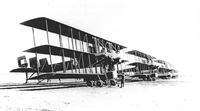 |
J.Davilla - Italian Aviation in the First World War. Vol.2: Aircraft A-H /Centennial Perspective/ (74)
|
| Lineup of Caproni Ca.4 heavy bombers in British service.
|
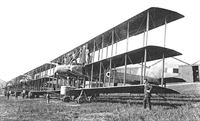 |
J.Davilla - Italian Aviation in the First World War. Vol.1: Operations /Centennial Perspective/ (73)
|
| Surviving photographs suggest that the Caproni Ca.4 triplanes were completed in two separate batches, in groups of two and four each. This photograph shows the four machines of the second sub-batch (if one can call it so) lined up at Taliedo. The Ca.4 carried a heavy bombload but was slow, cumbersome, and vulnerable to fighters. Caproni Family via Paolo Miana
|
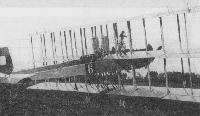 |
В.Кондратьев - Самолеты первой мировой войны
|
| "Капрони" Са.4 итальянской морской бомбардировочной эскадрильи.
|
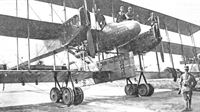 |
J.Davilla - Italian Aviation in the First World War. Vol.2: Aircraft A-H /Centennial Perspective/ (74)
|
| Caproni Ca.4 triplane bomber with bomb container.
|
 |
J.Davilla - Italian Aviation in the First World War. Vol.2: Aircraft A-H /Centennial Perspective/ (74)
|
| Caproni Ca.4 triplane bomber with ground crew that show the size of the aircraft.
|
 |
R.Abate, G.Alegi, G.Apostolo - Aeroplani Caproni: Gianni Caproni and His Aircraft, 1910-1983
|
| The war’s end did not spell the end of the great triplanes: in June 1919 aircraft 14664, used by 181st squadriglia during the war, made a promotional tour of northern Europe. It is seen here on Bruxelles-Haren airport, where on June 14 it carried King Albert of Belgium.
|
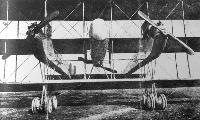 |
Jane's All The World Aircraft 1919 /Jane's/
|
| Front View of a Caproni Ca 4 type Triplane bomber of 1917.
|
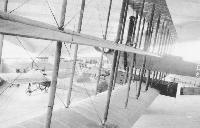 |
R.Abate, G.Alegi, G.Apostolo - Aeroplani Caproni: Gianni Caproni and His Aircraft, 1910-1983
|
| The photo, taken in 1940, shows the Ca.4 dominating the display.
|
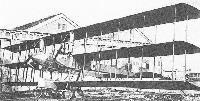 |
O.Thetford - British Naval Aircraft since 1912 /Putnam/
|
| The Caproni Ca 42, powered by three 400hp Isotta-Fraschini, or Libertys, was the last and the heaviest of the Caproni triplane bombers to be produced. Delivered in early 1918, these five-man machines carried up to 3.910lb of bombs in a central housing attached to the lower wing. Top level speed of the Ca 42 was 87mph at 6.560 feet, while its defensive armament consisted of five Ravelli machine guns. Over 20 of these mammoth triplanes were built, the machine seen here carrying the British serial no N 527, being the second of six Ca 42s operated by the RNAS for a period during 1918.
|
 |
Журнал - Flight за 1919 г.
|
| This three-engined 1,200 h.p. Caproni triplane, has a span of about 103 ft., and carries a useful load of several tons
|
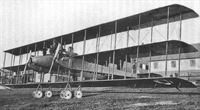 |
J.Davilla - Italian Aviation in the First World War. Vol.2: Aircraft A-H /Centennial Perspective/ (74)
|
|
|
 |
J.Davilla - Italian Aviation in the First World War. Vol.2: Aircraft A-H /Centennial Perspective/ (74)
|
| Caproni Ca.4 heavy bomber. The structure below the central nacelle is a bomb container.
|
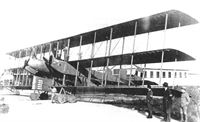 |
J.Davilla - Italian Aviation in the First World War. Vol.2: Aircraft A-H /Centennial Perspective/ (74)
|
| Caproni Ca.4 triplane bomber with bomb container.
|
 |
R.Abate, G.Alegi, G.Apostolo - Aeroplani Caproni: Gianni Caproni and His Aircraft, 1910-1983
|
| The people in this photo lend scale to the Ca.4’s considerable dimensions. Among other conspicuous details are the bomb harnesses on the lower central gondola, the twin wheels and night landing lights on the wing’s trailing edge.
|
 |
R.Abate, G.Alegi, G.Apostolo - Aeroplani Caproni: Gianni Caproni and His Aircraft, 1910-1983
|
| The war’s end did not spell the end of the great triplanes: in June 1919 aircraft 14664, used by 181st squadriglia during the war, made a promotional tour of northern Europe. It is seen here on Bruxelles-Haren airport, where on June 14 it carried King Albert of Belgium.
|
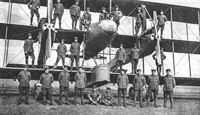 |
J.Davilla - Italian Aviation in the First World War. Vol.1: Operations /Centennial Perspective/ (73)
|
| RNAS Personnel of the 'Northern Squadron' posing with Caproni Ca.4 N-526, at Vizzola Ticino. The caption reads that the two aviators in the nacelle are F/SL B.G.H. Keymer and LM L.A. Comes.
|
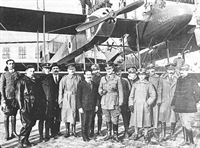 |
J.Davilla - Italian Aviation in the First World War. Vol.2: Aircraft A-H /Centennial Perspective/ (74)
|
|
|
 |
R.Abate, G.Alegi, G.Apostolo - Aeroplani Caproni: Gianni Caproni and His Aircraft, 1910-1983
|
| Despite the limited production run, the Ca.4 sported a large number of individual differences. British machines, for instance, carried twin Lewis guns in the nose, with the gunners position partially protected by a sort of collapsible screen. The photo also shows a large individual insignia and, less visible, a small eagle on the nose of N526.
|
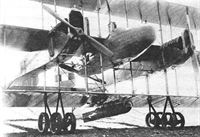 |
J.Davilla - Italian Aviation in the First World War. Vol.1: Operations /Centennial Perspective/ (73)
|
| Caproni Ca.42 bomber and load.
|
 |
R.Abate, G.Alegi, G.Apostolo - Aeroplani Caproni: Gianni Caproni and His Aircraft, 1910-1983
|
| Removing the lower gondola allowed heavier weights to be carried, such as the 500 kg bomb shown in the top right photo. This version was later called Ca.52.
|
 |
R.Abate, G.Alegi, G.Apostolo - Aeroplani Caproni: Gianni Caproni and His Aircraft, 1910-1983
|
| A Navy Ca.4 at take-off. This aerial giant served with the 181st and 182nd naval squadriglie.
|
 |
R.Abate, G.Alegi, G.Apostolo - Aeroplani Caproni: Gianni Caproni and His Aircraft, 1910-1983
|
| An airborne Ca.4. Photos cannot record the impression the Ca.4’s majestic size and power made in its day.
|
 |
R.Abate, G.Alegi, G.Apostolo - Aeroplani Caproni: Gianni Caproni and His Aircraft, 1910-1983
|
| A Ca.4 just after unsticking.
|
 |
Журнал - Flight за 1917 г.
|
| Another view of the 600 h.p. Italian Caproni triplane, which has been doing such good raiding work on the Italian front. The machine is seen returning from a flight.
|
 |
J.Davilla - Italian Aviation in the First World War. Vol.2: Aircraft A-H /Centennial Perspective/ (74)
|
| Caproni Ca.4 triplane bomber with bomb container and "CAPRONI" painted under the bottom wing. This was a Ca.4 that was shipped to New York for an exhibition in early 1919.
|
 |
R.Abate, G.Alegi, G.Apostolo - Aeroplani Caproni: Gianni Caproni and His Aircraft, 1910-1983
|
| The cockade on this Ca.4’s nose indicates examination by the US Army’s Bolling commission.
|
 |
R.Abate, G.Alegi, G.Apostolo - Aeroplani Caproni: Gianni Caproni and His Aircraft, 1910-1983
|
| British Ca.4 N528 fitted with a passenger gondola replacing the more usual bom nacelle.
|
 |
В.Обухович, А.Никифоров - Самолеты Первой Мировой войны
|
|
|
 |
Журнал - Flight за 1919 г.
|
| A TRI-MOTORED CAPRONI HYDRO-TRIPLANE: It has a span of 31 metres, and the useful load is 2 1/2 to 3 tons. It can be fitted with three 300 h.p. Flat or Liberty engines, and the speed is 140 kiloms. per hour.
|
 |
R.Abate, G.Alegi, G.Apostolo - Aeroplani Caproni: Gianni Caproni and His Aircraft, 1910-1983
|
| In 1920 Ca.4 5353 was converted into seaplane by adding a pair of floats not unlike those designed by Guidoni for the Ca.47. It was also experimentally equipped with two underwing torpedo harnesses. This version was indicated as Ca.43 in the postwar system.
|
 |
J.Davilla - Italian Aviation in the First World War. Vol.2: Aircraft A-H /Centennial Perspective/ (74)
|
| Caproni Ca.4 triplane bomber airframe, this is a variant of the Ca.4, later called Ca.51, with biplane tail, a gunner position in the tail, and Fiat A14 engines
|
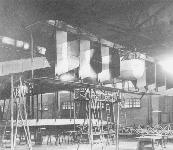 |
R.Abate, G.Alegi, G.Apostolo - Aeroplani Caproni: Gianni Caproni and His Aircraft, 1910-1983
|
| A final Ca.4 derivative was the Ca.51, easily recognized by its biplane horizontal tail. The rear gunner’s position can be made out amidst the six rudders.
|
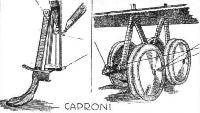 |
Журнал - Flight за 1919 г.
|
| Two detail sketches of the Caproni CA-4 Triplane. On the left one of the tail skids, and on the right one of the under-carriage units.
|
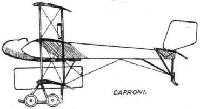 |
Журнал - Flight за 1919 г.
|
|
|
 |
Журнал - Flight за 1919 г.
|
|
|
 |
В.Кондратьев - Самолеты первой мировой войны
|
| "Капрони" Са.4
|
 |
J.Davilla - Italian Aviation in the First World War. Vol.2: Aircraft A-H /Centennial Perspective/ (74)
|
| Caproni Ca.4
|
 |
J.Davilla - Italian Aviation in the First World War. Vol.2: Aircraft A-H /Centennial Perspective/ (74)
|
| Caproni Ca.4
|
 |
J.Davilla - Italian Aviation in the First World War. Vol.2: Aircraft A-H /Centennial Perspective/ (74)
|
| Caproni Ca.4
|
 |
J.Davilla - Italian Aviation in the First World War. Vol.2: Aircraft A-H /Centennial Perspective/ (74)
|
| Caproni Ca.4
|





























































